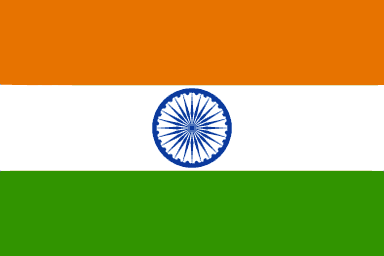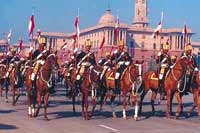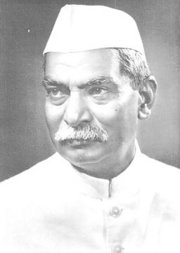Wish You A Very Happy Republic Day!
May You Be Ever Happy, Well and Secure!
May All Beings in This Universe Be Ever Happy, Well and Secure!
May You Live Long!
May You All Have Calm, Quiet, Alert, Attentive and An Equanimity Mind
With a Clear Understanding that Nothing is Permanent!

Blue Bunting

For The Gain of the Many and For the Welfare of the Many
http://www.youtube.com/watch?v=RRGfg-EBAfM&feature=related
http://www.youtube.com/watch?v=OCnGPIVI1No&feature=related
C.M. greets the people on Republic Day
Lucknow : January 25, 2008 The Uttar Pradesh Chief Minister, Km. Mayawati has greeted the people of the State on the occasion of Republic Day wishing for their prosperity, happiness and bright future. In a greeting message, the Chief Minister said that on Republic Day we remember the known and unknown martyrs and freedom fighters, whose sacrifice gave us freedom. On this day, we should also remember the propounders of social revolution Chhatrapati Shahuji Maharaj, Narayan Guru, Baba Saheb Bhim Rao Ambedkar and Manyawar Shri Kanshi Ram ji, who devoted their entire life for the cause of equality and economic independence to the downtrodden, backwards and poor people. The Chief Minister said that on the occasion of Republic Day we should seriously ponder that how far we have become successful in achieving the objectives of the constitution. She said that all of us should do our best efforts for the prosperity and peaceful atmosphere of the State, besides taking the resolve to strengthen the feeling of social harmony and brotherhood. ———
President addresses the ConservativesChandraBhan Prasad
The head of the Indian Republic represents the collective wisdom of the nation. He is also the official moderator of the nation’s conscience. And therefore, whenever he speaks up, he does so for the common good of society and the nation. A diverse society or rather, a complex one carries a dark past - a “shadow” from which the nation had to come clean when it evolved into a Republic in 1950. At the time of its birth, it mandated a manifesto for the entire nation, those at the seat of power were expected to translate the same into reality. That meant transforming India’s varna or caste ridden order into a civil one, where a citizen’s merit and wisdom alone would define his personality and standing in the civil order.
After half a century of experimentation, the nation has moved in that direction, but very slowly and very little. The Republic’s manifesto was, to begin with, seen with some contempt by the Indian polity. The political parties showed a considerable amount of reluctance when it came to pursuing the Republic’s goals. They feared intervening with the internal affairs of society. The end result, we all know. The crises have only grown and the Dalit and non-Dalit divide has widened. The slogan of “Progress” missed the cordial message of “Peace.” Now the nation is confronted with a new choice: “Progress with Social Peace” or “Progress without Social Peace.”
The post of the President is a political one. Anyone who occupies it is a political person. We live in and hail this era of liberal democracy. Democracy allows ideologies and political formations to contend “democratically.” In a society like ours, several political persuasions are allowed to grow. But under this vast political sun, the Head of the State, irrespective of his/her political beliefs, is a mirror in which every citizen can see his/her face, voice and aspirations. But at times, the President’s individual choices, beliefs and commitments find echo in his reflections. A President of Brahman origin may visit several temples and organise Mata Jagarans at Rashtrapati Bhavan, as also seek the blessings of one of the Shankaracharyas. Similarly, a President of Dalit origin may find it fit to attend Dr Ambedkar’s birth anniversary.
Which is why the nation was expecting a major portion of the President’s Republic Day eve speech to touch on anti-saffronisation or the dual policies being adopted by the White House on the issue of terrorism. After all, the Honourable KR Narayanan is considered to be ideologically Left of the Centre or to be precise, a scholarly person with Left inclinations. But the President, departing from his life long ideological convictions, took a line which not many expected. It is not for nothing that a leading English daily, while reporting his address, said, “The President made a major departure from the socialist tenor of his previous speeches.”
The President, in his address to the nation, included the following: “Even today, it is amazing that we have not become an inclusive society, in spite of the political triumph of our democracy. The discrimination being suffered by women, scheduled castes and scheduled tribes is a crying denial of the democracy that is enshrined in our Constitution. Recently, a conference of Dalit and tribal intellectuals and activists was held in Bhopal. They issued a declaration called the Bhopal Declaration, charting a new course for Dalits and the tribal people of the 21st century. After calling for the implementation of the policies, enshrined in our Constitution and aiming at their development, the declaration emphasises the importance, in this present era of privatisation, of providing representation for these deprived classes, not only in Government and public institutions but in private corporations and enterprises which benefit from Government funds and facilities. Indeed, in the present economic system and that of the future, it is necessary for the private sector to adopt social policies which are progressive and more egalitarian; for these deprived classes to be uplifted from their state of deprivation and inequality and given the rights of citizens and civilised human beings. This is not asking private enterprise to accept Socialism but to do something like what America, with its Diversity Bill and affirmative action, have adopted and are implementing. My fellow citizens, I have talked to you of these social questions because if our great democracy is to remain great and relevant to the problems of the masses, we will have to pay heed to these crying socio-economic issues.”
The President knows that globalisation is an irreversible process and that the Dalit masses will find themselves left out of a market economy. Hence, he found it necessary to remind the nation of the commitments made five decades ago. In doing so, he refers to the American experience. Dalits have always drawn inspiration from the Black movement and if the Blacks have, through their struggle, made inroads into the American economy, why not emulate the same in India? But, will the Conservative streams - the Sangh and the Left/Socialist, in particular - listen to the President’s voice?
Dr. B. R. Ambedkar
Dr. B. R. Ambedkar Bhimji Ramji Ambedkar was born on April 14th, 1891, in Mhow, Madhya Pradesh. His parents both were untouchables. His father was a retired army officer and headmaster in a military school, and his mother an illiterate woman.
Because he was born as a untouchable, he was made to sit in a corner of the class room, separated from other students. His teachers feared pollution, that is why they would not touch him. Despite all kinds of humiliations, he passed his high school in 1908. This was such an exceptional achievement for an untouchable, that he was felicitated in a public meeting
After his graduation he went to the USA to study economics at the Columbia University. After his return to India he got a job as Military Secretary in Baroda Raja’s office. Here he was ill-treated again by the upper caste employees. Even drinking water was not given to him and files were kept at a distance from him.
A great lawyer and Original Inhabitant of Jambudvipa that is the Great Prabuddha Bharath leader
In 1920 he went to London where he got his Bar-at-Law at Gray’s Inn for Law.
While coming back to India in 1923, Ambedkar again experienced humiliation. The upper caste lawyers would not even have tea at his desk. But his greatest consolation were his clients, whom he treated with a liberal mind. His reputation and fame among the Depressed Classes began to grow. He was one of the greatest thinkers that India has produced. He visualised and struggled for a casteless and equal India.
At this time he was fully convinced that nothing could emancipate the Original Inhabitants of Jambudvipa that is the Great Prabuddha Bharath except through a complete destruction of the caste system. He asserted: ‘I was born a Hindu, but never will die a Hindu. Hinduism should become a religion of social equality. What is required is to get rid of the doctrine of ‘Chatuvarna’. That is the root cause of all inequality and is also the parent of the caste system and untouchability, which are merely other forms of inequality’.
Ambedkar’s struggle for equality
In 1924 he started the organisation ‘Bahiskrit Hitakarini Sabha’, for the upliftment of the untouchables. Ambedkar adopted a two-pronged strategy:
- Eradication of illiteracy and economic uplift of the downtrodden.
- Non-violent struggle against visible symbols of casteism, like denial of entry into temples and drawing water from public wells and tanks.
Ambedkar won two major victories when the High Court of Bombay gave a verdict in favour of the untouchables and made a successful non-violent march and entry into a temple. The two struggles shook the religious foundation on which the caste system is built.
He formed a political party ‘Scheduled Castes Federation’ in April 1942. Ambedkar was also advocate of women’s rights. He struggled for women’s liberalisation from the caste-entrenched patriarchal system. At the conference of the Depressed Classes Women in Nagpur in 1942, he stated: ‘let every girl who marries stand by her husband, claim to be her husband’s friend and equal, and refuse to be his slave’.
Architect of the Constitution
He was the prime architect of the Constitution of independent India. In August 1947 a drafting committee was appointed to prepare a Draft Constitution. Dr. Ambedkar was the chairman of this committee. The Draft was submitted to the Governor General of India on February 21, 1948. The Constitution was finalised in November 1949 and came into force on January 26th, 1950; the day that India became a Republic. In that same year he became Law Minister in the first cabinet after Independence, but he resigned from the ministry as Nehru’s cabinet refused to pass the Women’s Rights Bill
Buddhism
Ambedkar was justifiably bitter and disenchanted with Hinduism and thus he changed his religion. In October 1956 he, along with about two lakh Original Inhabitants of Jambudvipa that is the Great Prabuddha Bharath men and women, converted to Buddhism in Nagpur. For Ambedkar Buddha was one of the main inspiring personalities in history who raised a strong voice of protest against inequality between people and between men and women.
On 6 December 1956 Dr. B. R. Ambedkar died. Original Inhabitants of Jambudvipa that is the Great Prabuddha Bharath will always remember him as their Liberator and Champion of their rights. ‘Rights are protected not by laws, but by the social and moral conscience of society’, Ambedkar said.
 Indian Republic Day, January 26th Indian Republic Day, January 26th |
|
Even before the Independence of India from the British rule on August 15, 1947, January 26th was celebrating in a different context. “It was the Lahore Session of the Indian National Congress at midnight of December 31, 1929 - January 1, 1930, that the Tri-Colour Flag was unfurled by the nationalists and a pledge taken that every year on January 26, the “Independence Day” would be celebrated and that the people would unceasingly strive for the establishment of a Sovereign Democratic Republic of India”.
|
 |
|
India became a Republic and the constitution came into force on January 26, 1950. The Constituent Assembly was convened and appointed a committee with Dr. B. R. Ambedkar as Chairman to draft the Constitution. India declared herself to be a Sovereign Democratic Republic. The Indian Constitution, the longest in the world, consist 397 articles and 12 schedules, which provides for a single citizenship for the whole of India.
|
||||||||||||||||||||||||||||||||||
C.M. grieved on the death of senior journalist Khurshid Kamil Kidwai
Lucknow : 25 January 2008 The Uttar Pradesh Chief Minister, Km. Mayawati has expressed profound grief over the sudden death of senior Journalist and former Bureau Chief UNI and Chief Editorial Advisor of Urdu Daily Avadhnama, Mr. Khurshid Kamil Kidwai. In a condolence message, the Chief Minister said that late Kidwai was a sensitive Journalist who always encouraged ideal journalism. He remained associated with several news papers. In his death, the world of journalism had suffered an irreparable loss, she added. The Chief Minister has conveyed her deep sympathies and heartfelt condolences to the family members and prayed for peace to the departed soul.
http://www.hindu.com/2008/01/26/stories/2008012656740700.htm

Online edition of India’s National Newspaper
Saturday, Jan 26, 2008
ePaper | Mobile/PDA Version
Mayawati knocks at Governor’s door for package
Special Correspondent
| Urges him to exercise his influence on the Centre to get special area package sanctioned |

Inside Lucknow: Uttar Pradesh Chief Minister Mayawati, under tight security, arrives at the main hall of her official residence on Friday to address a press conference.
LUCKNOW: Chief Minister Mayawati on Friday urged the Governor, T. V. Rajeswar, to exercise his influence on the Union Government to get the special area incentive package and other packages sanctioned at the earliest. Ms. Mayawati observed that the Governor should use his office in favour of the drought-stricken people of Bundelkhand region of Uttar Pradesh.
Mr. Rajeswar visited the Bundelkhand region on January 22 and 23, where he reportedly expressed his dissatisfaction at the pace of the drought-relief measures. Responding to the Governor’s remarks, and in an apparent bid to clear certain “misconceptions”, the Chief Minister on Friday shot off a three-page missive to him. She slammed the previous state governments, as well as the Centre, for their failure to retrieve the situation in the region which has been in the throes of drought for the past four years.
Ms. Mayawati noted that in the 60 years since Independence, non- Bahujan Samaj Party governments had been in power in Uttar Pradesh for 57 years, particularly the Congress which ruled the State for about 38 years. The Chief Minister accused these governments of ignoring the cause of Bundelkhand as a result of which it was today the most backward region of the State.
The Chief Minister assailed the UPA Government at the Centre for not sanctioning the packages demanded by her and said that in her meeting with Prime Minister Manmohan Singh on May 26 last year she had asked for his assistance in the development of the State. Thereafter, the Rs.80,000-crore special area incentive package for Bundelkhand and Purvanchal was presented to the Prime Minister on July 20, she added.
Stating that no action had been taken on the packages demanded, the Chief Minister said a Rs.3,750-crore special package was given for the Vidharba region in 2006 by the Central Government.
Ms. Mayawati accused the previous Samajwadi Party regime of taking no concrete measures for Bundelkhand, which was reflected in no drought relief money being sanctioned for Banda, Chitrakoot, Mahoba and Hamirpur in the past two years, whereas Rs.1 crore was released for Jalaun in 2005-06 and Rs.81 lakh for Jhansi district in 2006-07 by the Mulayam Singh regime.
The Chief Minister apprised the Governor of the measures taken by her government for mitigating the sufferings of the drought-hit people. She further apprised him of shortcomings in National Rural Employment Guarantee Act scheme and said some public measures like construction of school buildings, panchayat bhawans and cleaning of water drains in villages should be incorporated into the rural employment scheme.
New runway not planned: Aviation Ministry
Staff Reporter
KANCHEEPURAM: The Ministry of Civil Aviation has said that it had only applied for clearance from the Public Investment Board (PIB) for extending the secondary runway at the Chennai airport and not for constructing a new parallel runway.
According to a copy of a reply dated January 7 by the Airports Authority of India (AAI) to queries raised by the public under the Right to Information Act, the AAI seem to have never planned for constructing a new parallel runway on the northern side of the Adyar. Claiming that there were no technical and economic feasibility reports available for the construction of a parallel runway, it said no environmental impact assessment report had been prepared either. Distributing copies of the reply to the press on Thursday, Thamizh Selvan, Balesh and Sumathi of Tharapakkam said they were at a loss to comprehend why the State government was keen on acquiring 1,650 acres of land in Tharapakkam, Kolapakkam, Gerugembakkam, Kovur and Manapakkam.
The AAI had no plans of constructing a new runway . It had not yet obtained clearance from the PIB for the extension of the secondary runway.
“Such being the case, what is the need to speed up the process of land acquisition,” they wondered.







